 |
 |
 |
| |
Results of BENCHMRK-1, a Phase III Study Evaluating the Efficacy and Safety of Raltegravir (MK-0518), a Novel HIV-1 Integrase Inhibitor, in Patients with Triple-class Resistant Virus
|
| |
| |
Reported by Jules Levin
CROI, Feb 27, 2007, Los Angeles
The presentations at CROI for both the Merck integrase inhibitor MK-0518 and the Pfizer CCR5 antagonist maraviroc are a landmark in HIV drug development. These drugs are both the first in these new classes of integrase and CCR5. They are both potent and treatment-experienced patients should be fully sensitive to these drugs since they are new classes of drugs and patients have never before taken drugs from these classes. Both drugs are available through Expanded Access Programs from the two companies for patients that need them now, or you can wait until the drugs are approved by the FDA. Maraviroc is ahead in that the FDA hearing for the drug is April 24 meaning the drug should be available during the Summer. An FDA hearing for MK-0518 has not yet been announced but it could be during the Summer meaning the drug should be available before the end of 2007.
Brief summary of results:
Combined efficacy from both studies-- 79% had <400 c/ml in MK518 arm vs 43% for placebo group.
98% taking Fuzeon & TMC114 naively had <400 c/ml.
90% taking Fuzeon naively had <400 c/ml.
90% taking TMC114 naively had <400 c/ml.
74% not using TMC114 or Fuzeon had <400 c/ml.
Study authors summarized:
In patients with advanced HIV infection, failing ARTs with multi-drug resistant virus, raltegravir + OBT:
-- Was generally well tolerated
-- with safety profile comparable to that of placebo + OBT
-- with few adverse experiences leading to discontinuation
Had potent and superior antiretroviral activity compared to placebo + OBT at Week 16
-- Partial data at Week 24 shows similar response
-- When raltegravir was combined with enfuvirtide and/or darunavir, >90% achieved HIV RNA < 400 copies /mL
Study authors:
1Cooper, DA*; 2Gatell, J; 3Rockstroh, J; 4Katlama, C; 5Yeni, P; 6Lazzarin, A; 7Chen, J; 7Isaacs, R; 7Teppler, H; 7Nguyen, B-Y for the BENCHMRK-1 Study Group
1 Univ of NSW, Sydney, Australia; 2Univ of Barcelona, Spain; 3Univ of Bonn, Germany; 4Hosp Piti Salptrire, Paris, France; 5Hosp Bichat-Claude Bernard, Paris, France; 6San Raffaele Sci Inst, Milan, Italy; 7Merck Res Labs, PA, USA
BENCHMRK-1 and BENCHMRK-2:
Phase III Studies of Raltegravir
(MK-0518) a Novel HIV-1 Integrase Inhibitor
By the BENCHMRK-1 and BENCHMRK-2 Study Teams
BENCHMRK: Blocking integrase in treatment Experienced patients with a Novel Compound against HIV: MeRcK, MK-0518
BENCHMRK-1 (Protocol 018)
-- Europe, Asia/Pacific, Peru
BENCHMRK-2 (Protocol 019)
-- North and South America
BACKGROUND
Raltegravir:
A Novel HIV-1 Integrase Inhibitor
A new mechanism of action
Potent in vitro activity:
-- IC95 = 33 nM ± 23 nM in 50% human serum
Active against:
- multi-drug resistant HIV-1
- CCR5 and CXCR4 HIV-1
HIV resistant to raltegravir remain sensitive to other ARTs
Synergistic in vitro with all ARTs tested
Potent activity in combination therapy in Phase II studies:
-- in ART-naive patients at Week 24 (Markowitz et al, IAC 2006, Abst THLB0214)
-- 85 - 95% with HIV RNA < 50 copies/mL
In patients failing therapy with triple class resistant virus at Week 24 (Grinsztejn et al, ICAAC 2006, Abst H-1670b)
-- 57-67% with HIV RNA < 50 copies/mL
BENCHMRK-1 & 2: Study Design
2 identical ongoing Phase III studies (in different countries)
Randomized, double-blind, placebo controlled
Raltegravir 400 mg b.i.d. vs placebo (randomized 2:1)
-- All in combination with optimized background therapy (OBT)
-- Selected investigational ART permitted as OBT
Key Inclusion Criteria
-- Documented genotypic/phenotypic resistance to ≥ 1 drug in each of 3 classes (NNRTI + NRTI + PI)
-- HIV RNA > 1000 copies/mL
Endpoints at Week 16
-- HIV RNA and CD4 counts
-- Adverse experiences
DSMB monitored study
-- Patients virologically failing after ≥ 16 weeks of therapy could enter an open-label raltegravir arm (OLpVF)
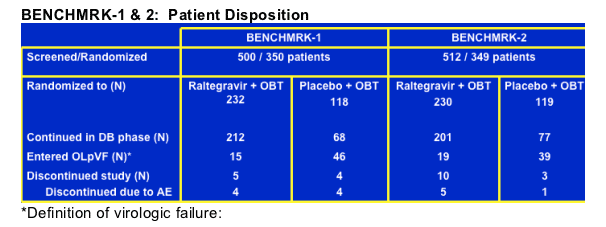
1) < 1 Log decline HIV from baseline and HIV RNA > 400 copies/mL at Wk 16 OR
2) virologic relapse: > 1 log increase HIV RNA above nadir or > 400 copies/mL from nadir after initial response < 400 copies/mL
BENCHMRK-1 & 2 : Baseline Patient Characteristics
Mean CD4 count was 150.
Viral load was 30,000 to 47,000.
92% had AIDS.
-- Median prior years of ARTs: 10-11; median number of ARTS: 12
-- % GSS 0/1 (genotypic sensitivity score): 30/33 for MK518, 29/41 for placebo in Benchmark 1; 20/44 for MK518, 26/40 for placebo in Benchmark 2.
-- % new Fuzeon in OBT: 19-21% for MK518; 20% for placebo.
-- % new TMC114 in OBT: 27% for MK518 & 25% for placebo in Benchmark 1; 45% for MK518 & 50% for placebo in Benchmark 2.
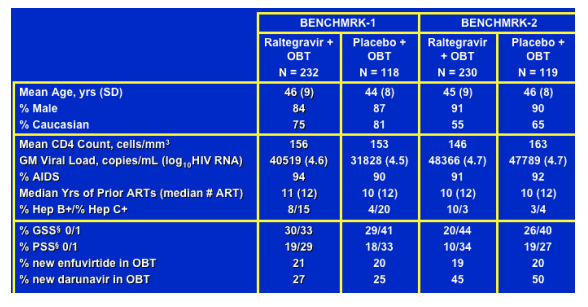
¤ GSS/PSS = total ART in OBT to which pt's virus showed geno/phenotypic sensitivity by Phenosense GT assay. Enfuvirtide and darunavir use in nave patients were each counted as + 1 active agent and added to GSS/PSS
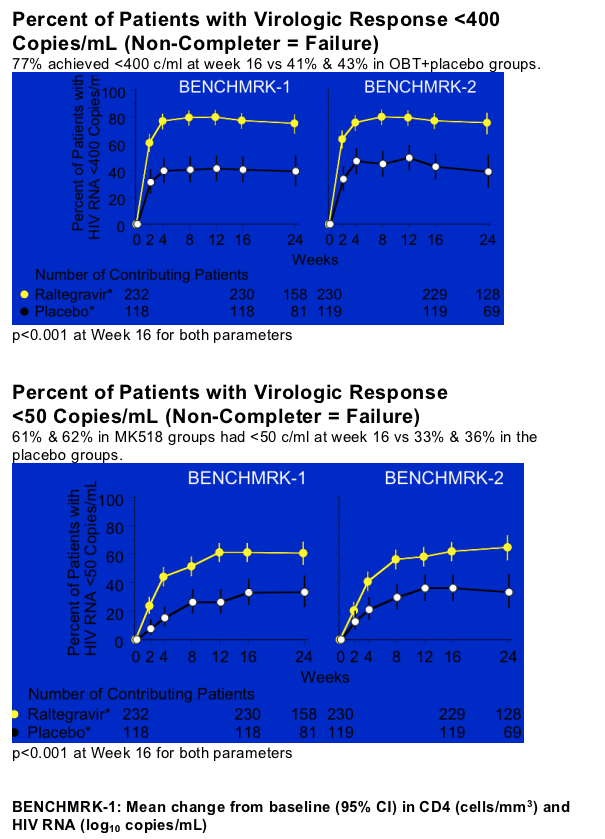
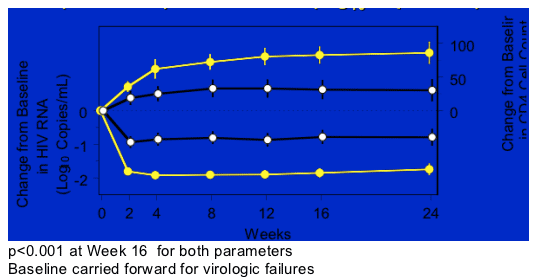
Partial Analysis of Raltegravir Resistance
in BENCHMRK-1 and BENCHMRK-2
Partial analysis based on genotyping 41 Raltegravir failures
32 with integrase changes, 9 with no consistent changes from baseline
Virologic failure on Raltegravir vs. placebo:
76 (16%) vs. 121 (51%)
Raltegravir failure was generally associated with one of two genetic pathways: N155H or Q148K/R/H
-- Additional mutations were observed with both pathways
N155H + (E92Q,V151I, T97A, G163R, L74M)
Q148K/R/H + (G140S/A, E138K)
-- Other pathways?
Y143R/C + (L74A/I, E92Q, T97A, I203M, S230R)
Mutations are proximal to catalytic center and are similar to those selected in vitro.
Longitudinal analyses and associations are in progress.
Results of BENCHMRK-2, a Phase III Study Evaluating the Efficacy and Safety of Raltegravir (MK-0518), a Novel HIV-1 Integrase Inhibitor, in Patients with Triple Class Resistant Virus
R. Steigbigel1, P. Kumar2, J. Eron3, M. Schechter4, M. Markowitz5, M. Loutfy6, J. Zhao7, R. Isaacs7, B.-Y. Nguyen7, and H. Teppler7 for the BENCHMRK-2 Study Group
1State Univ. of NY at Stony Brook, NY, USA; 2Georgetown Univ Med Ctr, Washington. DC, USA; 3Univ of N Carolina, NC, USA; 4Univ. Fed. de Rio de Janeiro, RJ, Brazil; 5Aaron Diamond AIDS Res Ctr, NY, USA; 6Canadian Immunodef Res Collab, Toronto, Canada; 7Merck Res Labs, PA, USA.
Combined Efficacy* (1) -
% Patients with HIV RNA < 400 copies/mL at Week 16 by Selected ARTs in OBT
Combined efficacy, 79% had <400 c/ml in MK518 arm vs 43% for placebo group.
98% taking Fuzeon & TMC114 naively had <400 c/ml.
90% taking Fuzeon naively had <400 c/ml.
90% taking TMC114 naively had <400 c/ml.
74% not using TMC114 or Fuzeon had <400 c/ml.
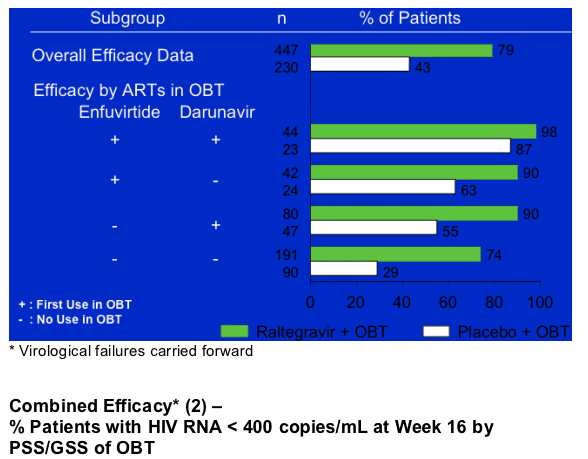
For patients on MK518 with 0 score on GSS 57% had <400 c/ml vs 10% on placebo; for patients with 1 on GSS who took MK518 85% had <400 c/ml vs 43% for placebo; for patients with 2 or more on GSS 89% taking MK518 vs 71% taking placebo had <400 c/ml.
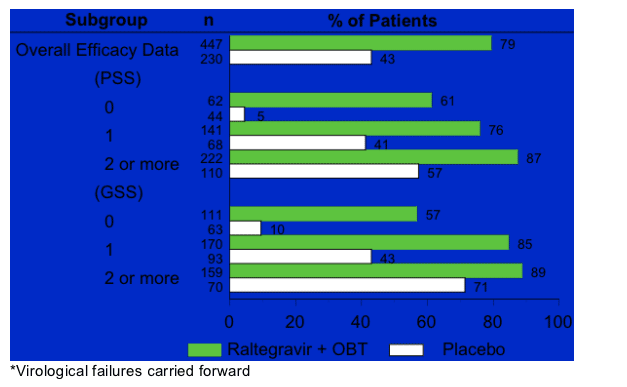
Combined Efficacy* (3) -
% Patients with HIV RNA < 400 copies/mL at Week 16 by Baseline HIV RNA and CD4 Cell Count
-- 88% taking MK518 vs 55% taking placebo with viral load <100,000 at baseline achieved <400 c/ml.
-- For patients with >100,000 c/ml at baseline, 64% taking MK518 vs 19% for placebo had <400 c/ml.
-- for patients with <50 CD4 at baseline, 63% on MK518 vs 24% taking placebo had <400 c/ml.
--patients with 50-200, 86% for MK518 vs 48% for placebo
-- patients with >200, 88% on MK518 vs 59% on placebo.
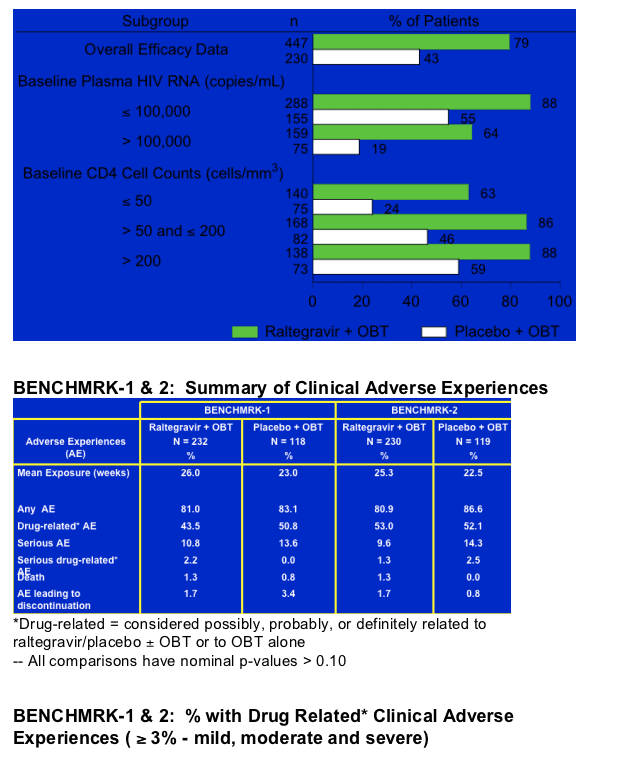
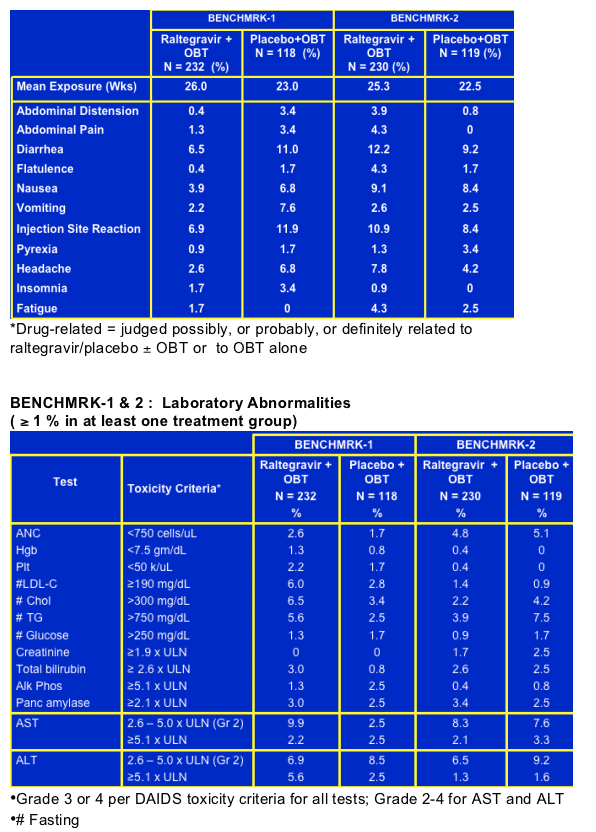
|
| |
|
 |
 |
|
|